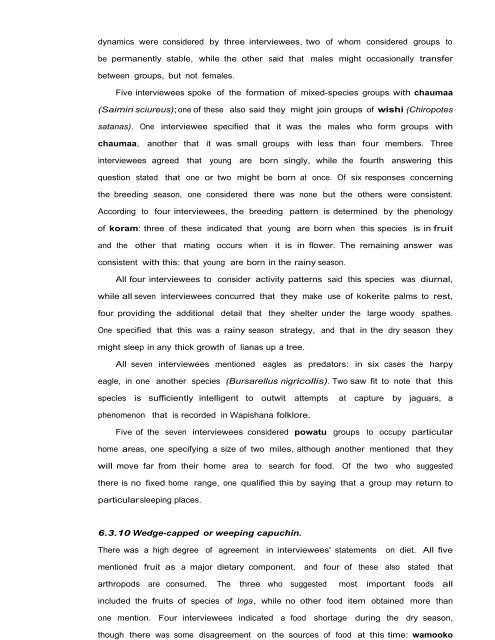Ethnoecology, Resource Use, Conservation And Development In A ...
Ethnoecology, Resource Use, Conservation And Development In A ...
Ethnoecology, Resource Use, Conservation And Development In A ...
You also want an ePaper? Increase the reach of your titles
YUMPU automatically turns print PDFs into web optimized ePapers that Google loves.
dynamics were considered by three interviewees, two of whom considered groups to<br />
be permanently stable, while the other said that males might occasionally transfer<br />
between groups, but not females.<br />
Five interviewees spoke of the formation of mixed-species groups with chaumaa<br />
(Saimiri sciureus); one of these also said they might join groups of wishi (Chiropotes<br />
satanas). One interviewee specified that it was the males who form groups with<br />
chaumaa, another that it was small groups with less than four members. Three<br />
interviewees agreed that young are born singly, while the fourth answering this<br />
question stated that one or two might be born at once. Of six responses concerning<br />
the breeding season, one considered there was none but the others were consistent.<br />
According to four interviewees, the breeding pattern is determined by the phenology<br />
of koram: three of these indicated that young are born when this species is in fruit<br />
and the other that mating occurs when it is in flower. The remaining answer was<br />
consistent with this: that young are born in the rainy season.<br />
All four interviewees to consider activity patterns said this species was diurnal,<br />
while all seven interviewees concurred that they make use of kokerite palms to rest,<br />
four providing the additional detail that they shelter under the large woody spathes.<br />
One specified that this was a rainy season strategy, and that in the dry season they<br />
might sleep in any thick growth of lianas up a tree.<br />
All seven interviewees mentioned eagles as predators: in six cases the harpy<br />
eagle, in one another species (Bursarellus nigricollis). Two saw fit to note that this<br />
species is sufficiently intelligent to outwit attempts at capture by jaguars, a<br />
phenomenon that is recorded in Wapishana folklore.<br />
Five of the seven interviewees considered powatu groups to occupy particular<br />
home areas, one specifying a size of two miles, although another mentioned that they<br />
will move far from their home area to search for food. Of the two who suggested<br />
there is no fixed home range, one qualified this by saying that a group may return to<br />
particular sleeping places.<br />
6.3.10 Wedge-capped or weeping capuchin.<br />
There was a high degree of agreement in interviewees' statements on diet. All five<br />
mentioned fruit as a major dietary component, and four of these also stated that<br />
arthropods are consumed. The three who suggested most important foods all<br />
included the fruits of species of <strong>In</strong>ga, while no other food item obtained more than<br />
one mention. Four interviewees indicated a food shortage during the dry season,<br />
though there was some disagreement on the sources of food at this time: wamooko


